Analysis on the Changes of Agro-Meteorological Thermal Indices in Northeast China under RCP4.5 Scenario Using the PRECIS2.1
Abstract
:1. Introduction
2. Study Area, Data, and Methods
2.1. Study Area
2.2. Model Data
2.3. Observation Data
2.4. Correction Data
2.5. Thermal Indices
3. Results
3.1. Validation of the Mean and Minimum Temperature and Thermal Indices
3.2. Changes of AT10, PGS and FFP during the 21st Century
3.3. Changes of the First and Last Days of PGS and FFP
4. Discussion
5. Conclusions
Supplementary Materials
Author Contributions
Funding
Acknowledgments
Conflicts of Interest
References
- Stocker, T.F.; Qin, D.; Plattner, G.K.; Tignor, M.; Allen, S.K.; Boschung, J.; Nauels, A.; Xia, Y.; Bex, V.; Midgley, B.M. Climate Change 2013: The Physical Science Basis; Contribution of Working Group I to the Fifth Assessment Report of the Intergovernmental Panel on Climate Change; Cambridge University Press: Cambridge, UK; New York, NY, USA, 2013. [Google Scholar]
- Smit, B.; Cai, Y. Climate change and agriculture in China. Glob. Environ. Chang. 1996, 6, 205–214. [Google Scholar] [CrossRef]
- Piao, S.; Ciais, P.; Huang, Y.; Shen, Z.; Peng, S.; Li, J.; Zhou, L.; Liu, H.; Ma, Y.; Ding, Y.; et al. The impacts of climate change on water resources and agriculture in China. Nature 2010, 467, 43–51. [Google Scholar] [CrossRef] [PubMed]
- Wang, J.; Mendelsohn, R.; Dinar, A.; Huang, J.; Rozelle, S.; Zhang, L. The impact of climate change on China’s agriculture. Agric. Econ. 2009, 40, 323–337. [Google Scholar] [CrossRef]
- Barichivich, J.; Briffa, K.R.; Osborn, T.J.; Melvin, T.M.; Caesar, J. Thermal growing season and timing of biospheric carbon uptake across the Northern Hemisphere. Glob. Biogeochem. Cycles 2012, 26. [Google Scholar] [CrossRef]
- Blinova, I.; Chmielewski, F.M. Climatic warming above the Arctic Circle: Are there trends in timing and length of the thermal growing season in Murmansk Region (Russia) between 1951 and 2012. Int. J. Biometeorol. 2015, 59, 693–705. [Google Scholar] [CrossRef] [PubMed]
- Chen, C.Q.; Qian, C.R.; Deng, A.X.; Zhang, W.J. Progressive and active adaptations of cropping system to climate change in Northeast China. Eur. J. Agron. 2012, 38, 94–103. [Google Scholar] [CrossRef]
- Li, Z.G.; Tang, H.J.; Yang, P.; Wu, W.B.; Chen, Z.X.; Zhou, Q.B.; Zhang, L.; Zou, J.Q. Spatio-temporal responses of cropland phenophases to climate change in Northeast China. J. Geogr. Sci. 2012, 22, 29–45. [Google Scholar] [CrossRef]
- Hu, Q.; Pan, X.B.; Shao, C.X.; Zhang, D.; Wang, X.X.; Wei, X.Y. Distribution and Variation of China Agricultural Heat Resources in 1961–2010. Chin. Agric. Meteorol. 2014, 35, 119–127. (In Chinese) [Google Scholar]
- Chen, H.; Li, Z.G.; Tang, P.Q.; Hu, Y.N.; Tan, J.Y.; Liu, Z.H.; You, L.Z.; Yang, P. Rice area change in Northeast China and its correlation with climate change. Chin. J. Appl. Ecol. 2016, 27, 2571–2579. (In Chinese) [Google Scholar]
- Cao, M.M.; Li, Q.; Zhang, L.Y.; Gao, J.; Li, W.H.; Ding, W.M.; Sun, Y. Accumulated Temperature Variation and Accumulated Temperature Rezone in Heilongjiang Province. Chin. Agric. Meteorol. 2014, 35, 492–496. (In Chinese) [Google Scholar]
- Moss, R.H.; Edmonds, J.A.; Hibbard, K.A.; Manning, M.R.; Rose, S.K.; Vuuren, D.P.; Carter, T.R.; Emor, S.; Kainuma, M.; Kram, T.; et al. The next generation of scenarios for climate change research and assessment. Nature 2010, 463, 747–756. [Google Scholar] [CrossRef] [PubMed]
- Sperber, K.R.; Annamalai, H.; Kang, I.S.; Kitoh, A.; Moise, A.; Turner, A.; Wang, B.; Zhou, T. The Asian summer monsoon: An intercomparison of CMIP5 vs. CMIP3 simulations of the late 20th century. Clim. Dyn. 2013, 41, 2711–2744. [Google Scholar] [CrossRef]
- Zhu, J.X.; Huang, G.; Wang, X.Q.; Cheng, G.H. Investigation of Changes in Extreme Temperature and Humidity over China through a Dynamical Downscaling Approach. Earth Future 2017, 5. [Google Scholar] [CrossRef]
- Gao, C.C. The Impact of Climate Change on China’s Crop Production: A CMIP5 Ensemble Assessment. In Proceedings of the 2012 First International Conference on Agro-Geoinformatics (Agro-Geoinformatics), Shanghai, China, 2–4 August 2012; pp. 1–5. [Google Scholar]
- Shen, S.H.; Yang, S.B.; Zhao, Y.X.; Xu, Y.L.; Zhao, X.Y.; Wang, Z.Y.; Liu, J.; Zhang, W.W. Simulating the rice yield change in the middle and lower reaches of the Yangtze River under SRES B2 scenario. Acta Ecol. Sin. 2011, 31, 40–48. [Google Scholar] [CrossRef]
- Hui, J.; Xie, L.Y.; Ma, Z.Y. The impacts of climate change on Chinese agriculture. Ann. Arid Zone 2008, 47, 325–342. [Google Scholar]
- Ye, M.Z.; Guo, J.P.; Yuan, B.; Zhao, J.F. Thermal resources and maize temperature suitability in Northeast China under climate change. Appl. Ecol. 2012, 23, 2786–2794. [Google Scholar]
- Ao, X.; Zhai, Q.F.; Cui, Y.; Zhou, X.Y.; Wang, T.; Zhao, C.Y.; Lin, R.; Yi, X. Characteristics and Trend Prediction of Accumulated Temperature in Northeast China. Available online: http://cpfd.cnki.com.cn/Article/CPFDTOTAL-ZGQX201611005004.htm (accessed on 15 July 2018).
- Chu, Z.; Guo, J.P.; Zhao, J.F. Impacts of projected climate change on agricultural climate resources in Northeast China. Acta Geogr. Sin. 2017, 72, 1248–1260. [Google Scholar]
- Wu, S.H.; Zheng, D.; Yin, Y.H.; Lin, E.D.; Xu, Y.L. Northward-shift of temperature zones in China’s eco-geographical study under future climate scenario. J. Geogr. Sci. 2010, 20, 643–651. [Google Scholar] [CrossRef]
- Xu, Y.L.; Pan, J.; Feng, Q. Projection on Future Climate Change in China-Constructing High Resolution SRES Climate Scenarios Using PRECIS; Science Press: Beijing, China, 2016. (In Chinese) [Google Scholar]
- Jones, C.D.; Hughes, J.K.; Bellouin, N.; Hardiman, S.C.; Jones, G.S.; Knight, J.; Liddicoat, S.; O’Connor, F.M.; Andres, R.J.; Bell, C. The HadGEM2-ES implementation of CMIP5 centennial simulations. Geosci. Model. 2011, 4, 543–570. [Google Scholar] [CrossRef] [Green Version]
- Estévez, J.; Gavilán, P.; Giráldez, J.V. Guidelines on validation procedures for meteorological data from automatic weather stations. J. Hydrol. 2011, 402, 144–154. [Google Scholar] [CrossRef] [Green Version]
- Xu, Y.L.; Zhang, Y.; Lin, Y.H.; Lin, E.D.; Lin, W.T.; Dong, W.J.; Richard, J.; David, H.; Simon, W. Using PRECIS to analyze the climate change response of China under the SRES B2 scenario. Chin. Sci. Bull. 2006, 51, 2068–2074. [Google Scholar] [CrossRef]
- Zhang, Y.; Xu, Y.L.; Dong, W.J.; Cao, L.J.; Michael, S. A future climate scenario of regional changes in extreme climate events over China using the PRECIS climate model. Geophys. Res. Lett. 2006, 33. [Google Scholar] [CrossRef] [Green Version]
- Yang, H.L.; Xu, Y.L.; Zhang, L.; Pan, J.; Li, X. Projected change in heat waves over China using the PRECIS climate model. Clim. Res. 2010, 42, 79–88. [Google Scholar] [CrossRef] [Green Version]
- Zhang, Y.J.; Fu, L.; Pan, J.; Xu, Y.L. Projected Changes in Temperature Extremes in China Using PRECIS. Atmosphere 2017, 8, 15. [Google Scholar] [CrossRef]
- Zhang, M.T.; Zhang, Y.J.; Tong, J.H.; Li, K.; Pan, J.; Xu, Y.L. Characteristics of agricultural climate resources in the potential northward migration area of winter wheat under future climate scenarios. Clim. Chang. Res. 2017, 13, 1673–1719. (In Chinese) [Google Scholar]
- Xu, Y.; Gao, X.J.; Shen, Y.; Xu, C.H.; Shi, Y.; Giorgi, F. A daily temperature dataset over China and its application in validating a RCM simulation. Adv. Atmos. Sci. 2009, 26, 763–772. [Google Scholar] [CrossRef] [Green Version]
- Hu, Q.; Pan, X.B.; Zhang, D.; Yang, N.; Li, Q.Y.; Shao, C.X. Variation of Temperature and Frost-free Period in Different Time Scales in Northeast China. Chin. J. Agrometeorol. 2015, 36, 1–8. (In Chinese) [Google Scholar]
- Liu, D.; Zhang, J.H.; Meng, F.C. Effects of different soil moisture and air temperature regimes on the growth characteristics and grain yield of maize in Northeast China. Chin. J. Ecol. 2013, 32, 2904–2910. [Google Scholar]
- Liu, C.B.; Ji, X.X.; Xu, Y.L.; Wang, M.X.; Zhang, L.; Pan, J.; Hu, Y.N.; Tong, J.H. Analysis of Changes in the Maximum and Minimum Temperature and Diurnal Temperature Range from PRECIS Model under the SRES A1B Scenario for China. Clim. Environ. Res. 2015, 20, 89–96. (In Chinese) [Google Scholar]
- You, Q.L.; Min, J.Z.; Fraedrich, K.; Zhang, W.; Kang, S.C.; Zhang, L.; Meng, X.H. Projected trends in mean, maximum, and minimum surface temperature in China from simulations. Glob. Planet. Chang. 2014, 112, 53–63. [Google Scholar] [CrossRef]
- Chen, L.; Frauenfeld, O.W. Surface Air Temperature Changes over the Twentieth and Twenty-First Centuries in China Simulated by 20 CMIP5 Models. J. Clim. 2014, 27, 3920–3937. [Google Scholar] [CrossRef]
- Liu, J.; Du, H.B.; Wu, Z.F.; Hong, S.H.; Wang, L.; Zong, S.W. Recent and future changes in the combination of annual temperature and precipitation throughout China. Int. J. Climatol. 2017, 37, 821–833. [Google Scholar] [CrossRef]
- Guo, D.L.; Wang, H.J. Comparison of a very-fine-resolution GCM with RCM dynamical downscaling in simulating climate in China. Adv. Atmos. Sci. 2016, 33, 559–570. [Google Scholar] [CrossRef] [Green Version]
- Bennett, K.E.; Walsh, J.E. Spatial and temporal changes in indices of extreme precipitation and temperature for Alaska. Int. J. Climatol. 2015, 35, 1434–1452. [Google Scholar] [CrossRef]
- Tang, X.; Yang, X.C.; Tian, Z.; Günter, F.; Sun, L.X.; Pan, J. Impacts of Climate Change on Agro-Climatic Resources in China. Resour. Sci. 2011, 33, 1962–1968. (In Chinese) [Google Scholar]
- Yang, R.Z.; Zhou, G.S. Spatio-temporal distribution of maize chilling damage intensity in the Three Provinces of Northeast China During 1961 to 2013. Acta Ecol. Sin. 2016, 36, 4386–4394. (In Chinese) [Google Scholar]
- Wu, J.D.; Wang, S.L.; Zhang, J.M. A Numerical Simulation of the Impacts of Climate Change on Water and Thermal Resourced in Northeast China. Resour. Sci. 2000, 22, 36–42. (In Chinese) [Google Scholar]
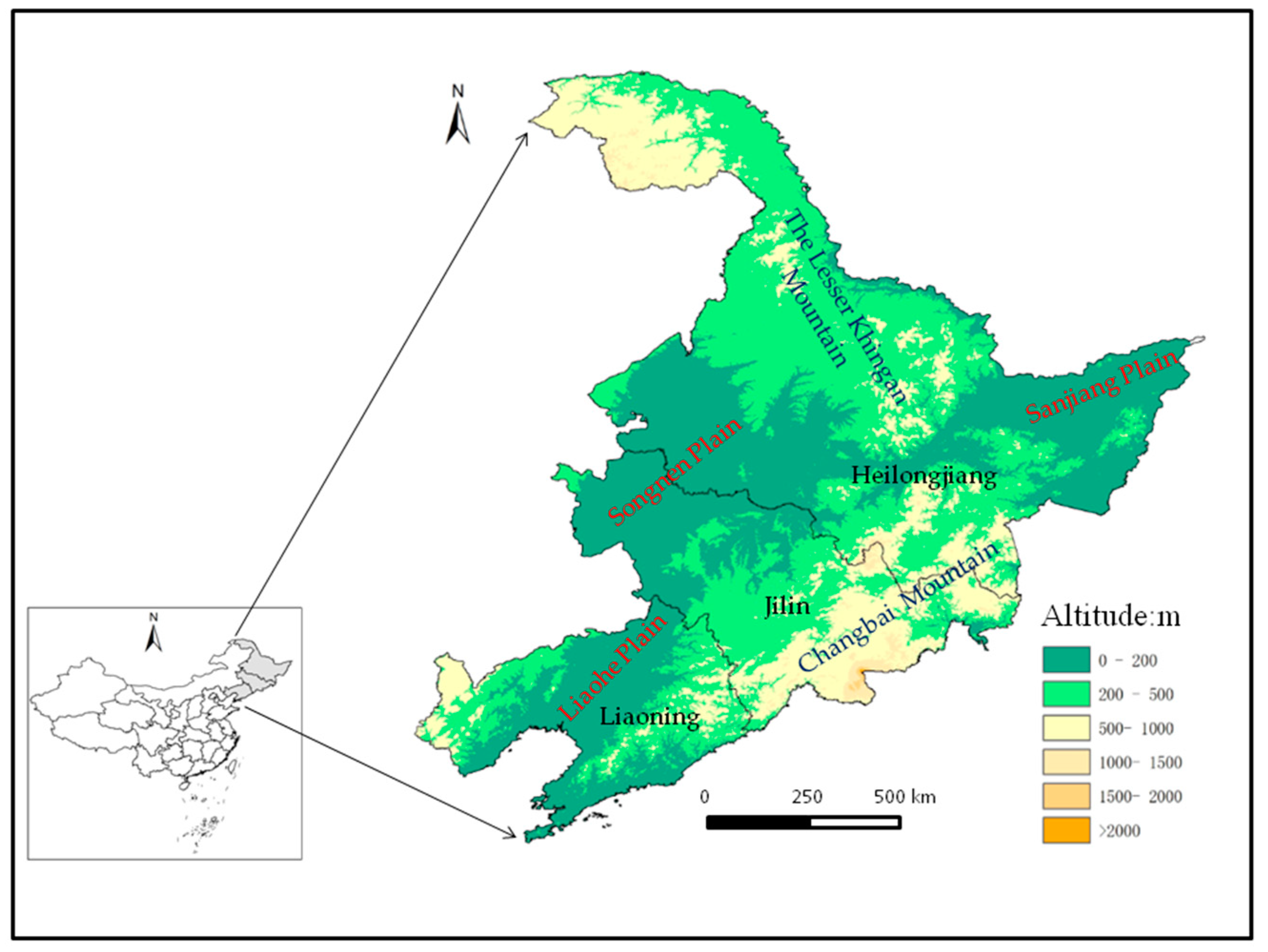
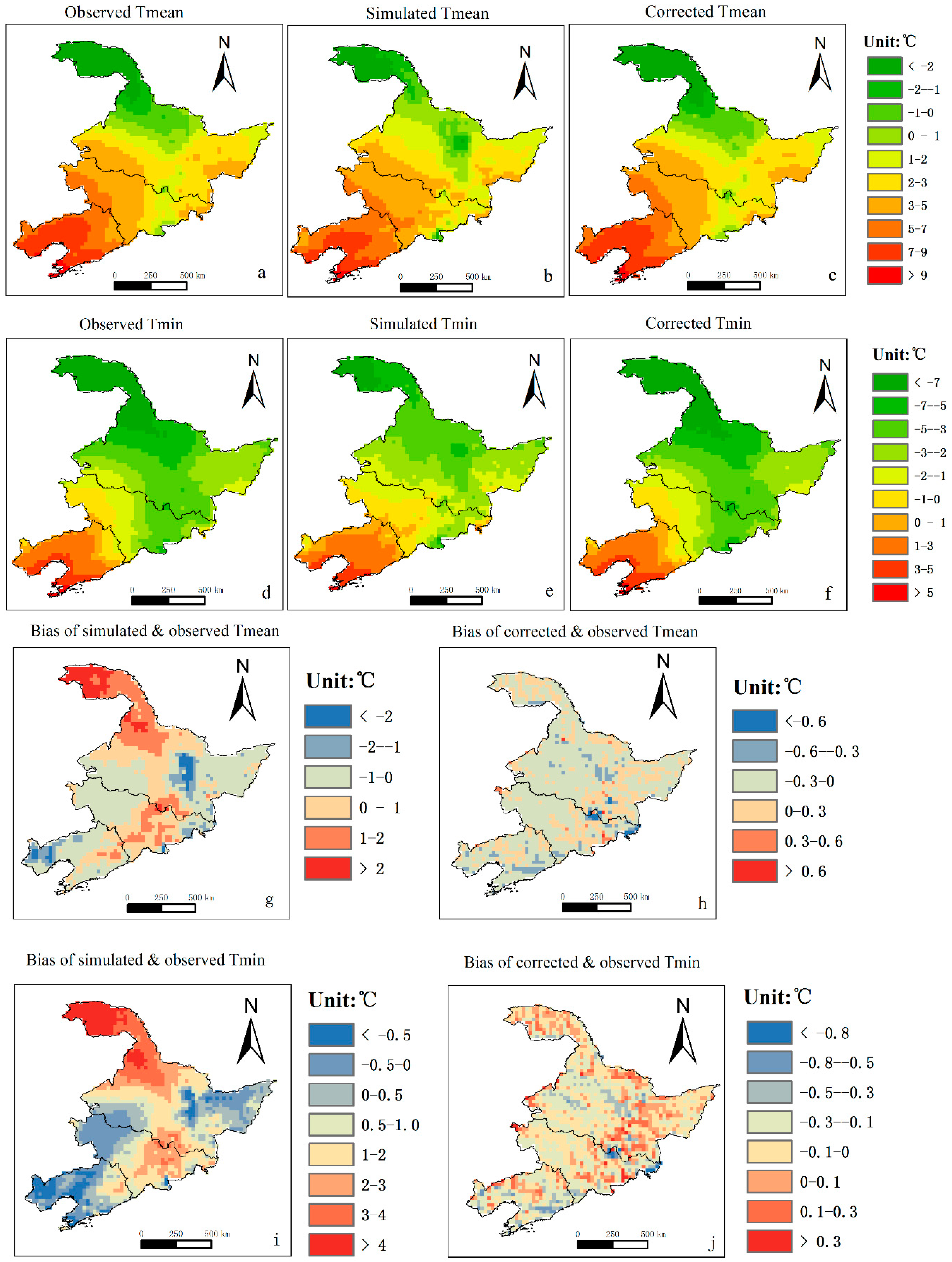
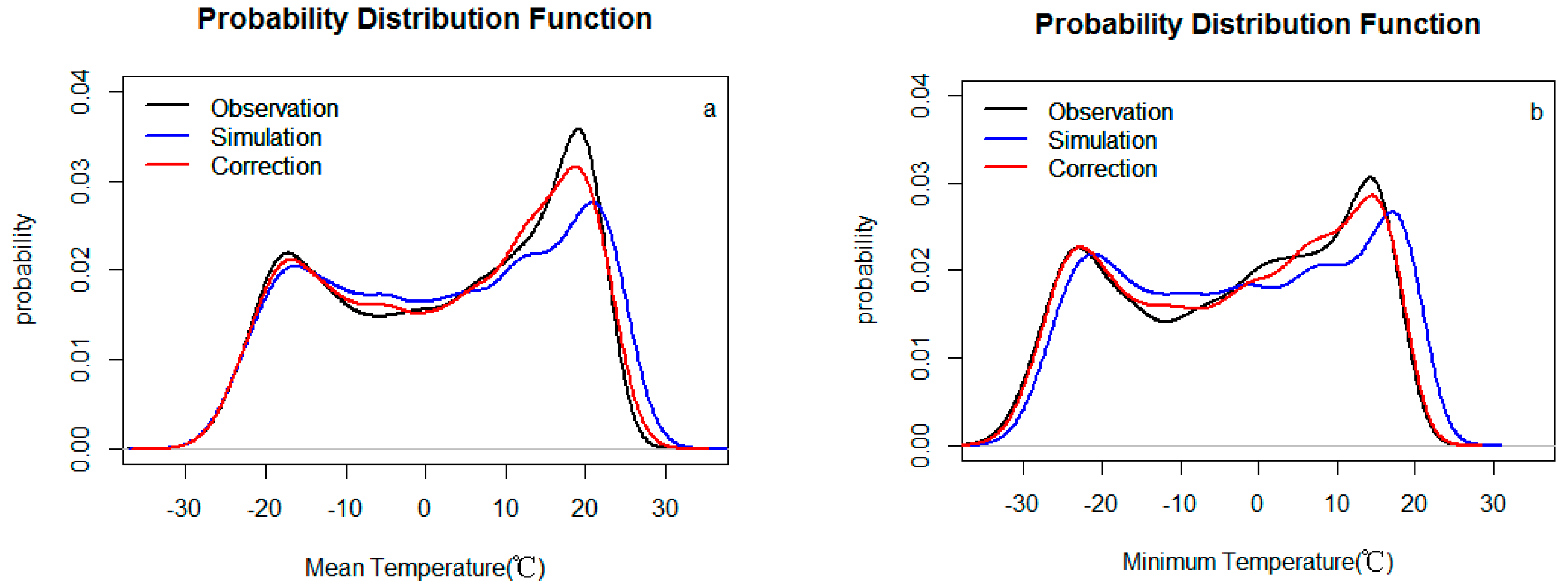
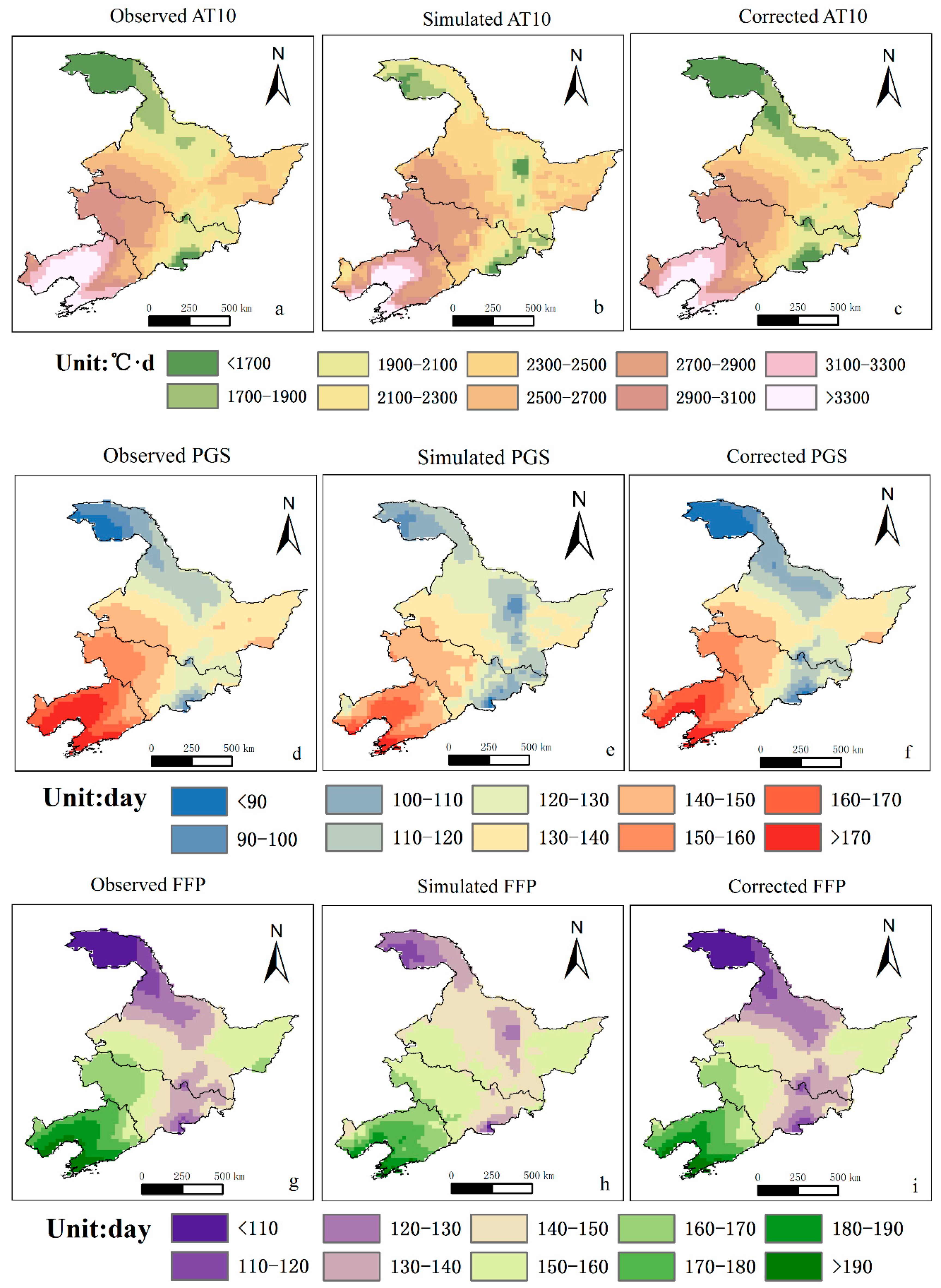
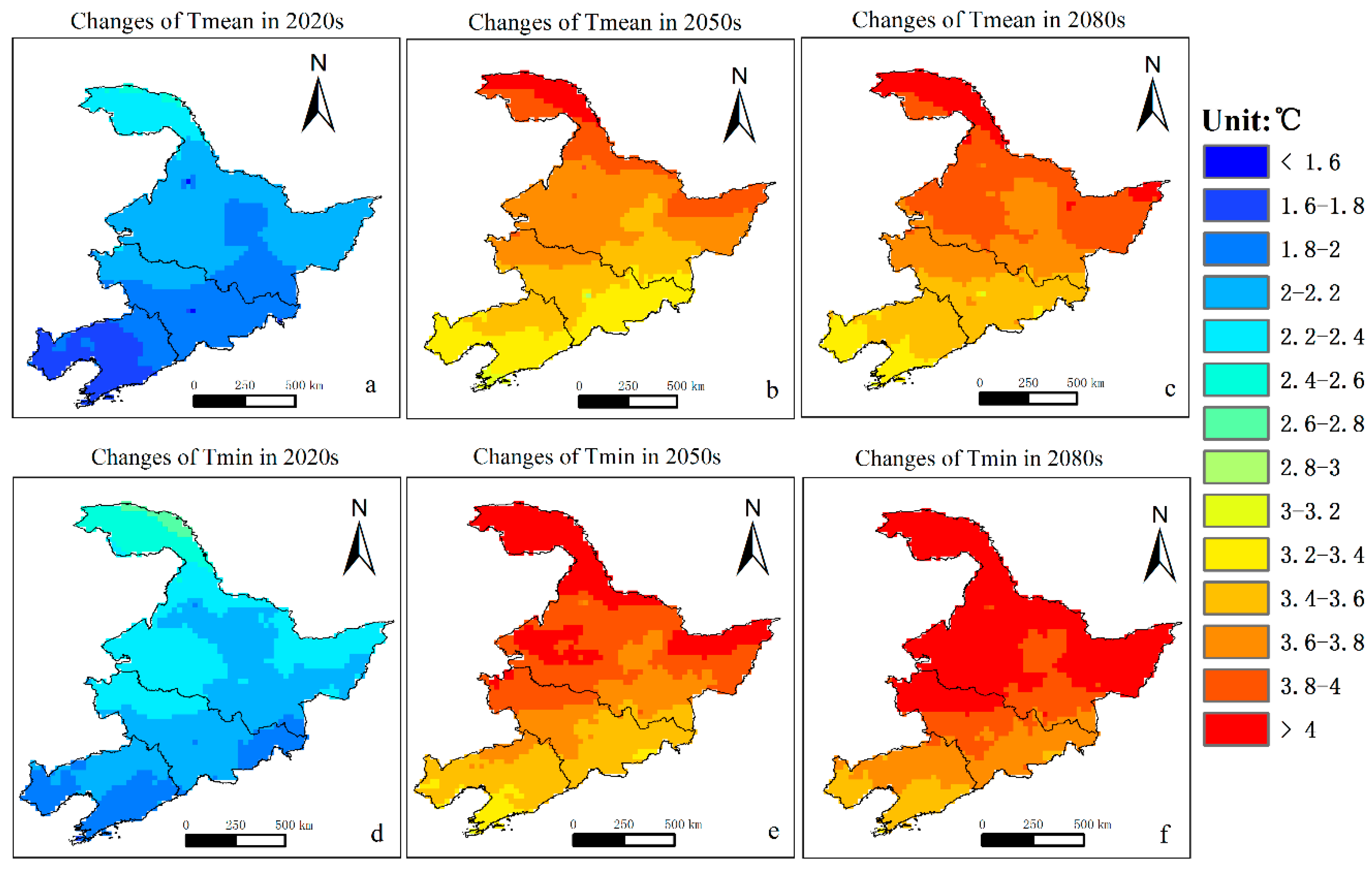
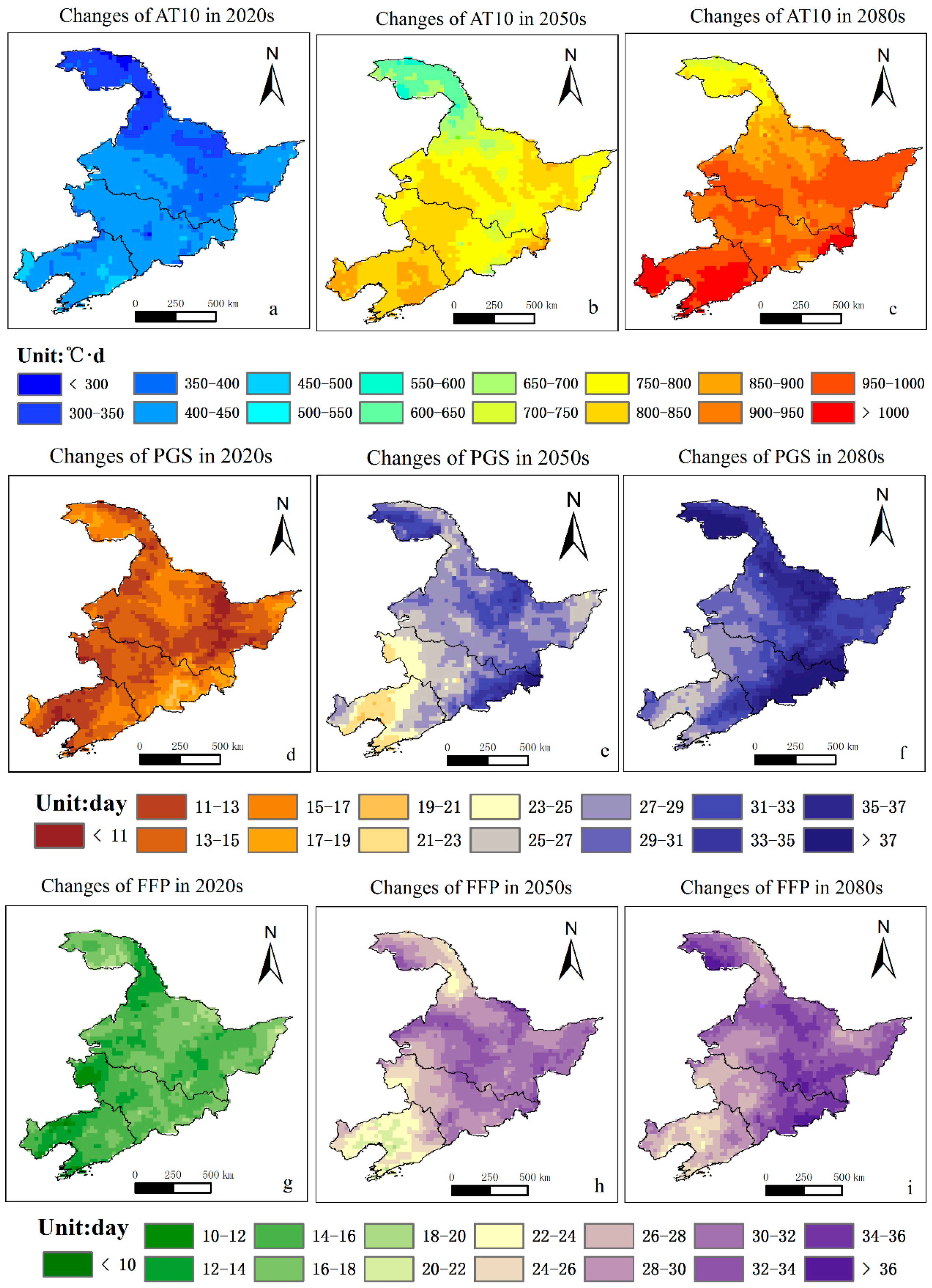
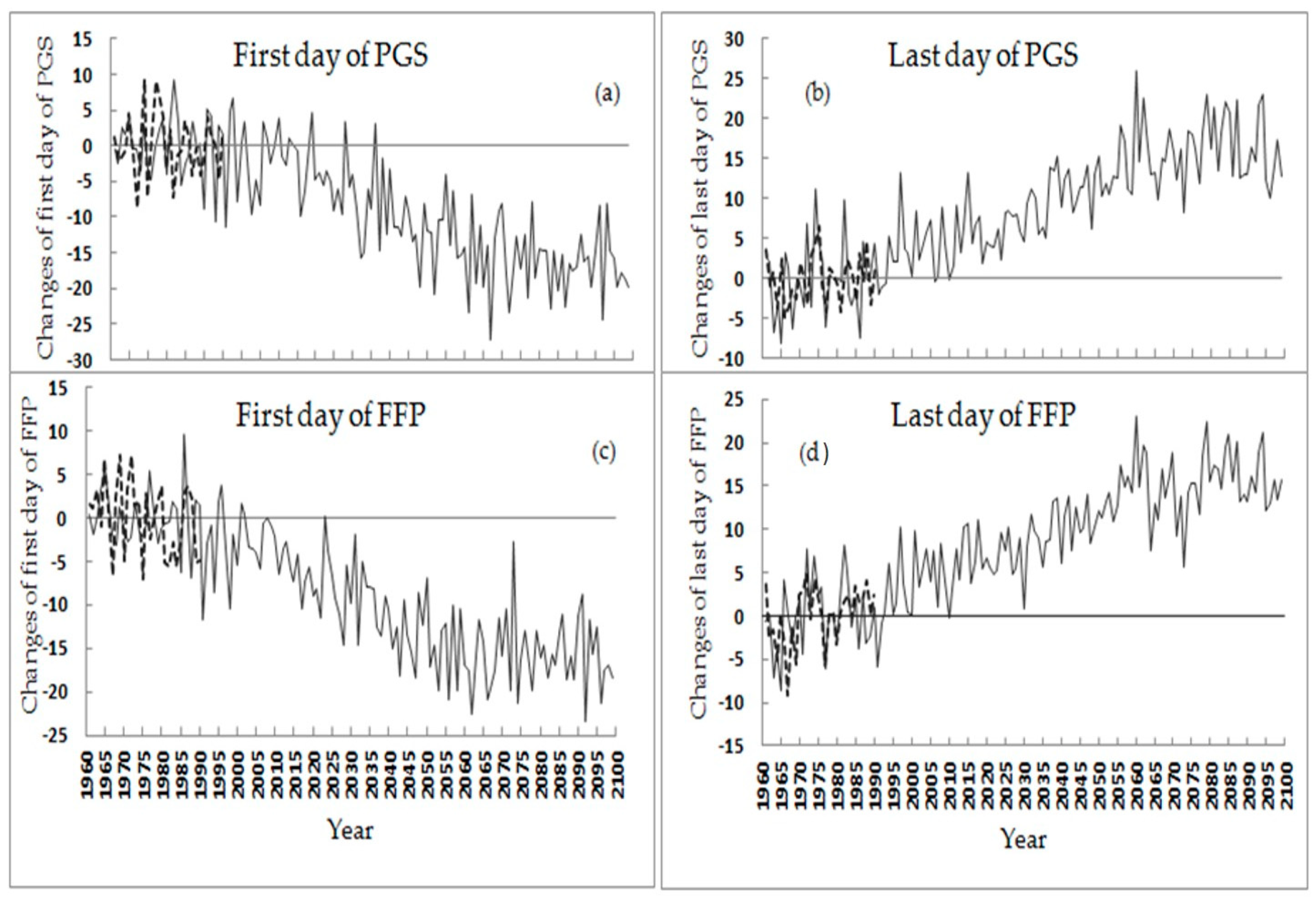
| Code | Index | Description | Unit |
|---|---|---|---|
| AT10 | Accumulated temperature ≥ 10 °C | Accumulated temperature value during daily air mean temperature (Tmean) ≥ 10 °C 1 period. | °C·day |
| PGS | Potential growing season | Annual (1st of January to 31st of December) count days with Tmean ≥ 10 °C. FD-PGS means the first occurrence date of PGS, and LD-PGS means the last occurrence date of PGS. | day |
| FFP | Frost-free period | Annual (1st of January to 31st of December) count days with daily air minimum temperature (Tmin) ≥ 2 °C 2. FD-FFP means the first occurrence date of FFP, and LD-FFP means the last occurrence date of FFP. | day |
| Indices (Unit) | 2020s | 2050s | 2080s |
|---|---|---|---|
| Tmean (°C) | 1.6–2.4 | 3.2–4.0 | 3.4–4.0 |
| Tmin (°C) | 1.8–2.6 | 3.4–4.2 | 3.6–4.2 |
| AT10 (°C·day) | 300–450 | 650–850 | 750–1000 |
| PGS (day) | 12–20 | 22–32 | 26–36 |
| FFP (day) | 10–18 | 22–30 | 24–34 |
© 2018 by the authors. Licensee MDPI, Basel, Switzerland. This article is an open access article distributed under the terms and conditions of the Creative Commons Attribution (CC BY) license (http://creativecommons.org/licenses/by/4.0/).
Share and Cite
Li, X.; Xu, Y.; Meng, C.; Zhang, L.; Wang, C. Analysis on the Changes of Agro-Meteorological Thermal Indices in Northeast China under RCP4.5 Scenario Using the PRECIS2.1. Atmosphere 2018, 9, 323. https://doi.org/10.3390/atmos9080323
Li X, Xu Y, Meng C, Zhang L, Wang C. Analysis on the Changes of Agro-Meteorological Thermal Indices in Northeast China under RCP4.5 Scenario Using the PRECIS2.1. Atmosphere. 2018; 9(8):323. https://doi.org/10.3390/atmos9080323
Chicago/Turabian StyleLi, Xinhua, Yinlong Xu, Chunchun Meng, Lei Zhang, and Changgui Wang. 2018. "Analysis on the Changes of Agro-Meteorological Thermal Indices in Northeast China under RCP4.5 Scenario Using the PRECIS2.1" Atmosphere 9, no. 8: 323. https://doi.org/10.3390/atmos9080323




